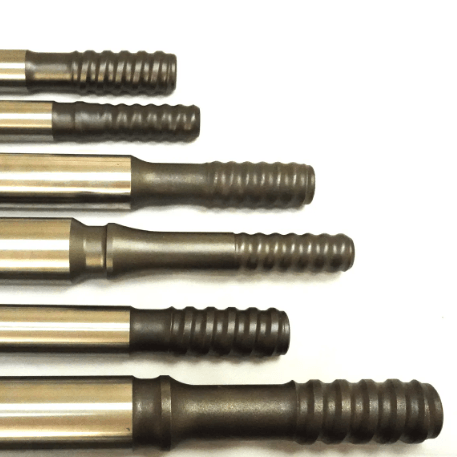In the world of rock drilling, ensuring efficient and reliable performance hinges on the connection between your top hammer drill and the drill string. This is where the shank adapter plays a critical role. This guide will delve into the intricacies of shank adapters, explaining their function, different types, and why choosing the right one is crucial for your drilling operations. Whether you are working in a quarry, a tunnel, or any other demanding drilling environment, understanding shank adapters is key to maximizing productivity and minimizing downtime.
1. What is a Shank Adapter and Why is it Essential for Your Drill?
A shank adapter, sometimes referred to as a drill shank adapter or simply a shank, is a crucial component in the top hammer drilling system. It acts as the vital link between the rock drill and the drill rod. Essentially, the shank adapter is designed to transmit the impact energy from the rock drill's piston to the drill string, which ultimately powers the drill bit to break the rock. Without a properly functioning shank adapter, the energy transfer would be inefficient, leading to reduced drill performance, increased wear and tear, and potential damage to your equipment.
Think of the shank adapter as the hand firmly gripping a hammer. It needs to be robust enough to withstand repeated high-impact forces and precisely engineered to ensure efficient energy transfer. A well-designed shank adapter not only maximizes the drill's performance but also protects the more expensive components of the drill string and the rock drill itself. Different various brands of rock drills require specific shank adapters, making the selection process an important one. The integrity of this connection is paramount for successful and cost-effective drilling operations.
2. Understanding the Different Types of Shank Adapters: Matching Your Drill to the Right Fit
The market offers a variety of shank adapters, each designed to fit specific rock drill models and drilling conditions. These different shank adapters are generally categorized by their thread type and size, which directly correspond to the specifications of the rock drill and the drill rod. Common thread types include T38, T45, and R32, among others. The selection of the appropriate shank adapter is critical for compatibility and optimal performance. For instance, a T45 shank adapter is designed to work with drill rods that have a T45 thread.
Furthermore, shank adapters can be categorized by their design, such as male or female threads, and whether they are designed for hydraulic or pneumatic rock drills. Understanding these nuances is essential. A female shank adapter will have internal threads, while a male shank adapter will have external threads. Hydraulic shanks generally have different connection points and internal mechanisms compared to pneumatic shanks. Consulting your rock drill's manual and understanding the specific requirements is the first step in selecting the correct shank adapter. Manufacturers like Atlas Copco, Sandvik, Furukawa, Tamrock, and Montabert have their own specific shank designs.
3. Drill Shank Design: Key Considerations for Optimal Performance
The design of the drill shank, which is the part of the shank adapter that interfaces directly with the rock drill's piston, is crucial for efficient energy transfer and service life. Key considerations in drill shank design include the shape and dimensions of the striking face, the presence and design of water channels for flushing, and the material and heat treatment of the shank itself. The striking face needs to be precisely machined to ensure full contact with the piston, maximizing the impact energy transferred.
The design of water channels is also critical, especially for external flushing systems, which are considered superior to internal flushing. External flushing uses a water tube that fits into the drill and into an o-ring seal in the end of the shank. Water exits through holes or a slot required in the side of the shank. These channels must line up between seals inside the front head or water box of the rock drill. This allows for greater volumes of flushing agent to be delivered with less risk of leakage and hammer damage from water. The materials used, often alloy structural steel, and the heat treatment process determine the shank's resistance to wear, fatigue, and deformation under repeated impact. Proper design ensures longer service life and consistent performance.

4. What Role Does the Drill Shank Adapter Play in Top Hammer Drilling?
The primary role of the drill shank adapter in top hammer drilling is to efficiently transmit the percussive energy generated by the rock drill's hammer piston to the drill string. This involves withstanding significant impact energy and torque. The shank adapter also plays a crucial role in aligning the drill string with the rock drill, ensuring that the force is applied directly along the axis of the drill. This proper alignment is vital for preventing bending stresses and premature failure of the drill rods and other components.
Furthermore, the shank adapter often incorporates features for water or air flushing, which is essential for removing cuttings from the borehole and cooling the drill bit. The design of the flushing system within the shank adapter directly impacts the efficiency of cuttings removal and the lifespan of the drill bit. In essence, the shank adapter is a critical interface that ensures the smooth and effective operation of the entire top hammer drilling system. Its performance directly affects the drill's penetration rate, the service life of the drill tools, and the overall cost of the drilling project.
5. Choosing the Correct Drill Shank Adapter for Your Rock Drill: Key Factors to Consider
Selecting the right drill shank adapter is paramount for maximizing drilling efficiency and minimizing downtime. Several key factors must be considered in this selection process. First and foremost is compatibility with your specific rock drill model. Different various brands of rock drills have unique shank designs and thread requirements. Consulting your rock drill's manufacturer specifications or a reputable supplier like Litian Heavy Industry Machinery Co., Ltd. is essential.
The type of drilling application also plays a crucial role. For instance, extension applications where high bending stresses are present may require shank adapters made from specific alloy steels with enhanced durability. The thread type and size (e.g., T38, T45, R32) must match the drill rods you intend to use. Consider the flushing requirements of your drilling operation. Do you require external or internal flushing? Ensure the shank adapter has the appropriate water or air channels. Finally, consider the quality and reputation of the manufacturer. Choosing a professional manufacturer focused on precision and reliability will ensure longer service life and consistent performance.
6. T38, T45, and R32 Shank Adapters: What are the Differences and When are They Used?
T38, T45, and R32 are common thread designations for shank adapters and drill rods, representing different thread profiles and sizes. The "T" designation typically indicates a thread profile used by Sandvik and Tamrock, while "R" is a designation often associated with Atlas Copco. The numbers (38, 45, 32) roughly correspond to the nominal diameter of the thread in millimeters. A T38 shank adapter will have a smaller and finer thread compared to a T45 shank adapter.
The choice between these thread types often depends on the size and power of the rock drill and the drilling conditions. R32 threads are generally used for smaller rock drills and lighter-duty applications. T38 and T45 threads are more common for medium to large-sized hydraulic top hammer drills used in quarry, tunnel, and construction drilling. T45 threads offer greater strength and are often preferred for applications where high bending stresses are present. Understanding the specific thread requirements of your drill string and rock drill is crucial for selecting the compatible shank adapter.
7. Hydraulic vs. Pneumatic Shank Designs: Which is Right for Your Operation?
The design of a shank adapter often differs depending on whether it's intended for a hydraulic or pneumatic rock drill. Hydraulic shanks generally incorporate more complex internal features for oil lubrication and sealing, as hydraulic systems operate with pressurized oil. They might have additional ports and channels for oil flow and specialized seals to prevent leakage and hammer damage.
Pneumatic shanks tend to have simpler internal designs, focusing on the transfer of impact energy from the air-powered piston. While both types of shank adapters perform the same basic function of transmitting energy, their internal mechanisms and connection points differ significantly. Hydraulic shanks generally be identified by their more robust construction and the presence of additional ports for oil lines. Pneumatic shanks tend to be lighter and have simpler connection interfaces. Using the incorrect type of shank adapter for your rock drill can lead to inefficient operation and potential damage.
8. Ensuring Longevity: Tips for Maintaining Your Drill Shank and Shank Adapter
Proper maintenance is crucial for maximizing the service life of your drill shank and shank adapter. Regular inspection is key. Check for signs of wear, cracks, or deformation, especially on the striking face and threaded connections. Ensure that the threads are clean and free from debris. Proper lubrication is also essential, particularly for hydraulic shanks. Follow the manufacturer's recommendations for lubricant type and application frequency.
When assembling the drill string, ensure that the shank adapter is securely tightened to the rock drill and the drill rod with the correct torque. Avoid over-tightening, which can damage the threads. Proper handling during transportation and storage can also prevent damage. Avoid dropping or subjecting the shank adapter to unnecessary impacts. Implementing a regular maintenance schedule will not only extend the service life of your shank adapters but also contribute to the overall efficiency and reliability of your drilling operations.
9. When Space Matters: How Shank Adapters Aid in Confined Drilling Environments
In drilling environments where space is limited, such as underground roof bolting or certain tunneling applications, the design and size of the shank adapter can be particularly important. In situations where the drilling space is limited and the total feed length is important, choosing a shank adapter with a compact design can be advantageous. This allows for greater maneuverability and reduces the overall length of the drill string, making it easier to operate in confined spaces.
Furthermore, the flushing method employed by the shank adapter can also be a factor in tight spaces. External flushing systems, while often more efficient, might require slightly more clearance for the water tubes. Internal flushing, where the flushing agent passes through the center of the drill rod, might be preferred used when the drilling space is particularly constrained. Careful consideration of the shank adapter's dimensions and flushing capabilities can significantly improve drilling efficiency and safety in confined environments.
10. Partnering with a Reliable Supplier for Your Drill Shank Adapter Needs
Choosing a reliable supplier for your drill shank adapters is crucial for ensuring quality, compatibility, and consistent performance. A professional manufacturer focused on precision and reliability, like Litian Heavy Industry Machinery Co., Ltd., will offer shank adapters made from high-quality materials with precise machining and heat treatment. They should also have a knowledgeable team that can assist you in selecting the correct shank adapter for your specific rock drill and drilling conditions.
A reputable supplier will also provide excellent customer support and timely delivery. Look for suppliers who offer a comprehensive range of shank adapters to suit suitable for various rock drill models and drilling applications. Building a strong partnership with a trusted supplier will ensure that you have access to high-quality drill tools that contribute to the efficiency and profitability of your drilling operations.
Key Takeaways:
- Shank adapters are critical components that transmit energy from the rock drill to the drill string.
- Different types of shank adapters exist, including T38, T45, and R32, each suited for specific drill models and conditions.
- Understanding the difference between hydraulic and pneumatic shank designs is essential for proper selection.
- Proper maintenance, including regular inspection and lubrication, is crucial for extending the service life of your shank adapters.
- In confined spaces, choosing a compact shank adapter can improve maneuverability.
- Partnering with a reliable supplier ensures access to high-quality and compatible shank adapters.
For a comprehensive selection of rock drilling tools, including high-quality shank adapters, explore our range of shank adapters. Ensure a secure and efficient connection with our durable couplings. Maximize your drilling performance with our robust drill rods.
Post time: 1 月-07-2025














